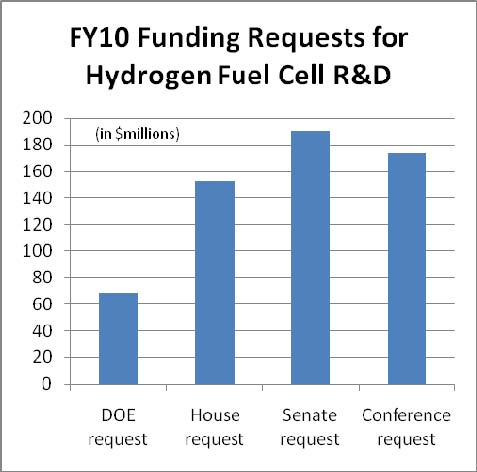Despite being expensive, inefficient, and ineffective, hydrogen fuel cell technologies have received more than $1.4 billion in federal funding in the past five years.1 While other more economical technologies much closer to practical realization exist, Congress continues to put taxpayer dollars toward HFC technologies, even after the Administration proposed more than $100 million in spending cuts for hydrogen fuel cells in the FY10 budget.2
What is a Hydrogen Fuel Cell?
A hydrogen fuel cell (HFC) is an electrochemical conversion device that produces electricity from hydrogen and oxygen.3 Although hydrogen is the most abundant element in the universe, it does not exist in nature in its pure form: pure hydrogen must be produced from natural gas, coal, biomass or water.4,5,6 Proponents support HFC technology because water is the only by-product of energy production, but the HFC supply chain is energy-intensive, extremely costly and in vehicles often results in higher carbon emissions than many gasoline-fueled cars.7,8
A Prohibitively Expensive Technology
The methods for producing hydrogen are exorbitantly expensive. Hydrogen is most often derived from natural gas, coal or biomass and all of these sources are costly and produce significant carbon dioxide emissions, defeating the development of HFC as a gasoline alternative. Producing hydrogen from water through electrolysis is also prohibitively expensive. The infrastructure required to power electrolysis using wind or solar would cost trillions, and using nuclear power would require the hundreds of new nuclear reactors and more uranium than is currently produced globally.9 This cost barrier to viable implementation is illustrated by the estimated $2 million price tag on Honda’s FCX Clarity, a HFC vehicle prototype.10
Distribution from the point of production to point of demand is also very costly. Because of hydrogen’s extremely low volumetric energy density, it requires roughly 22 compressed hydrogen tube trailers** to deliver the same amount of energy as a single gasoline tanker.11 Pipeline delivery is not much better: for example, to transport hydrogen 865 miles, an input of 1.5kg of hydrogen is required for just 1kg of hydrogen to reach the destination.12 Furthermore, hydrogen’s chemical properties cause pipelines to be more prone to fracturing, making transport even more expensive and potentially dangerous.13
An Inefficient Energy Carrier
Adding to total cost, hydrogen itself is a wasteful energy carrier; hydrogen requires large amounts electricity to produce, package, store, distribute and transfer. Moreover, energy loss occurs at each phase of this supply chain: only about 20-28% of the original power generated can be recovered for end use.14 For example, cars that are directly powered by electricity are able to utilize more than 60% of the original power, making them three times as efficient as HFC cars.15,16
Not an Effective Climate Solution
Supporters tout the virtues of the HFC as a “zero [carbon] emission” technology, but that is often not the case: deriving pure hydrogen from fossil fuels or biomass produces a significant amount of CO2.17 Even by producing hydrogen through water electrolysis, the barriers to development make any significant reduction in greenhouse gasses doubtful. Scientists, including Department of Energy (DOE) Secretary Steven Chu, increasingly agree that HFC vehicle technology has too long of a timeline to justify diverting a significant amount of resources toward it, considering that superior alternatives already exist.18,19
Congress has appropriated about $1.4 billion for hydrogen and fuel cell research and development since 2004.20 In a promising move for taxpayers in the FY 10 budget, DOE Secretary Steven Chu proposed a more than $100 million cut for hydrogen and fuel cell technologies.21 Unfortunately, Congress had different ideas: the House requested $153 million for hydrogen fuel cell research and the Senate requested $190 million, as seen in the accompanying figure. Ultimately, the two chambers agreed to appropriate $174 million to the Hydrogen Technology Program, ignoring DOE’s request to cut it to $68 million.
Prevent More Government Funding
Industry sources and the National Research Council have estimated that hydrogen fuel cell research may need up to $55 billion in government support over the next fifteen years.22 With more than $1.5 billion dollars already spent on hydrogen fuel cell research in the past fifteen years, the technology is still four major “miracles” away from practical application, according to Secretary Chu.23 With other more viable alternatives available, continuing to finance hydrogen fuel cells is a blatant waste of taxpayer dollars.
It’s time to cut the hydrogen fuel cell funding and save taxpayers $174 million.
**Transportation trailers that consist of high-pressure hydrogen tanks varying in length from 20 to 38 feet.
For more information, please contact Autumn Hanna at (202) 546-8500 x112 or autumn[at]taxpayer.net











